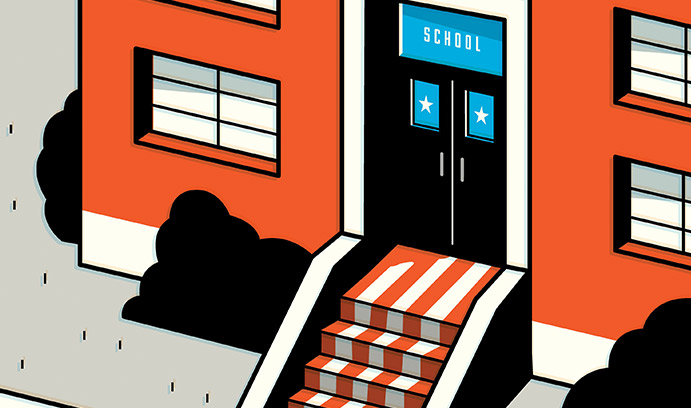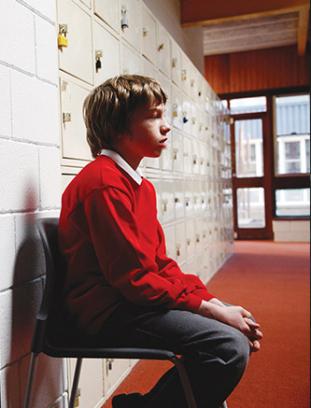Can We Curb School Violence?

Lee Kern, director of the Center for Promoting Research to Practice and professor of Special Education, addresses the issue of school violence in "I Profess."
By Lee Kern,
Director of Lehigh's Center for Promoting Research to Practice and professor of Special Education
Each day we hear disturbing news reports of violence in our nation's schools. The regularity of these stories leads us to believe that schools are no longer safe places for our children. And, students are not the only victims of school violence. Teachers are regularly assaulted at school as well.
So, can we curb school violence? The answer is yes...but it takes some work.
How do we create safe and supportive school environments and reach struggling children and adolescents? First, we need to understand the nature of student behavior in schools. A depiction of problem behavior among a school's student body has emerged from several decades of research. In almost every school studied, the majority of students (approximately 80 percent) rarely, if ever, exhibit behavior problems at school (i.e., violations of the code of conduct such that the student receives some type of disciplinary referral). So, the majority of students receive no, or just one, disciplinary referral during a school year. Approximately 15 percent of students can be classified as "at risk" engaging in periodic behavior problems (i.e., they receive two to five disciplinary referrals per year). The remaining roughly 5 percent have chronic and serious emotional and behavioral problems and engage in ongoing behavior problems.
In addition to a portrayal of student behavior, we also must understand the manner in which schools address student problems when they arise. That is, we need to know what works and does not work from a historical perspective. In response to behavioral infractions, schools have traditionally applied punitive procedures, such as detention, suspension or expulsion, in the hopes that these aversive responses would deter students from engaging in future problem behaviors. Numerous large-scale and well-conducted research studies, however, reveal just the opposite outcome. That is, when schools apply highly punitive and restrictive procedures, there is actually an increase in problem behaviors, such as rebellion toward teachers, vandalism against school property and absenteeism and truancy.
If punishment is not effective, then how do we address behavior problems? The solution is to develop a positive approach that prevents problems from emerging and also provides supports for students with more serious mental health and behavioral problems. Such an approach involves leveled or tiered support in which all students receive some form of universal prevention, while at-risk students and those with severe emotional and behavioral problems are provided increasingly intensive interventions and supports as needed, depending on their responsiveness. This approach creates a school culture where students feel welcomed and supported and teachers have a consistent and effective way to interact with students and address problems. Its effectiveness has been demonstrated in schools throughout the United States and abroad, including those in high-risk neighborhoods. Furthermore, because the approach is preventive and intensive support is reserved only for those most in need, it is also efficient in terms of time and resources.
To illustrate, schools establish, define and teach expectations to the entire student body (termed Tier 1 intervention). Unlike many codes of conduct that emphasize infractions (e.g., No tardies, No cursing), expectations are stated positively and intended to teach students what they should do when they are at school (e.g., Arrive at class before the bell rings, Use polite words). By teaching expectations to all students, problem behaviors among those who may have had little experience with structured or social environments can be avoided. Further, teachers and school staff are also taught procedures to acknowledge and reward students who are adhering to expectations (making the system overwhelmingly focused on students who behave appropriately) and how to consistently respond to infractions with efforts to re-teach desirable behavior. Data are collected to identify students who continue to receive disciplinary referrals and need additional support (Tier 2 intervention).In addition, schoolwide screening for mental health problems is conducted to identify students with problems that would not otherwise be noticed, such as depression or anxiety, and appropriate intervention is provided.
Students needing Tier 2 intervention typically receive support in small groups. The assumption is that these students need additional skills (e.g., social), monitoring or mentoring to learn how to interact or self-regulate their behavior. For instance, the most commonly used Tier 2 intervention is the implementation of a student behavior monitoring system whereby a student "checks in" with a designated school staffer each morning to discuss daily expectations, receives a behavior rating from her teacher at the end of each class period, "checks out" with the staff member at the end of each day to discuss her accomplishments and goals, brings the behavior ratings home for parent signature, then returns the rating sheet the following morning. Likewise, small-group cognitive behavioral interventions are highly effective at reducing symptoms of depression and anxiety.
For the 5 percent of students with more serious and intransigent problems, intervention is individualized and multicomponent, and derived through a comprehensive assessment process. The assessment process identifies environmental variables that may be modified to help support the student (e.g., abbreviated testing situations), skill deficits that need to be remediated (e.g., intensive reading instruction, anger control), and structured school and community supports for mental heath concerns.
Is it easy to turn around a failing school? The answer is no, especially when school staff are frustrated and burned out. It calls for effective school leadership, a collective commitment to make improvements and systems to sustain change efforts over time. But in the long run, it is well worth the effort for students, their families, school personnel and society in general.
Posted on:



